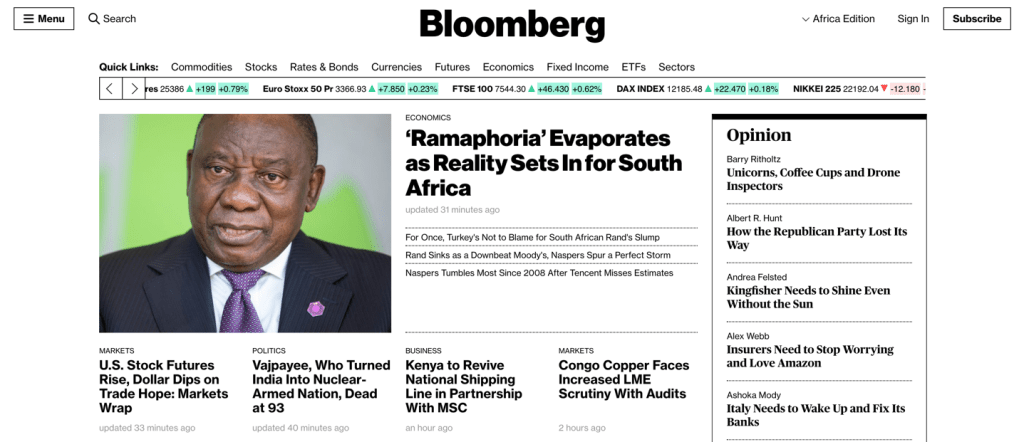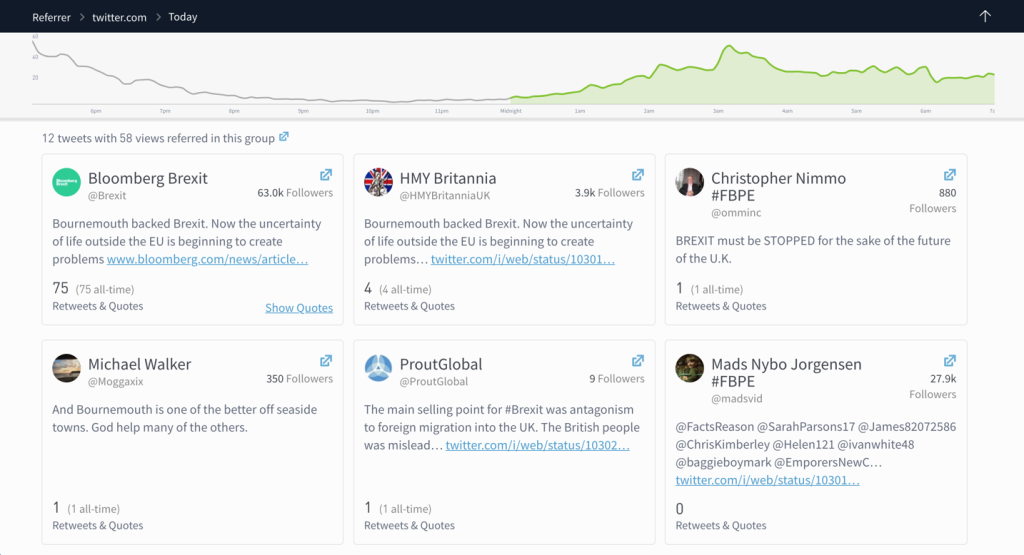To scale globally, Bloomberg starts local. This business news site uses Parse.ly to understand what content connects with international audiences.
It’s safe to assume that the priorities and interests of a business reader in China and the U.S. aren’t exactly the same. But for Bloomberg, those differences weren’t obvious. Any meaningful information about their smaller international audiences in Europe, Africa, and Asia was drowned out by their large U.S. following.
“Once you move into the afternoon, when the U.S. day is in full swing, local stories or even top performers are crowded out by big-hitting, widely shared U.S. posts,” said Adam Blenford, Managing Editor of Digital in Europe.
At the beginning of 2017, this inability to see the interests and habits of audiences outside the U.S. was a problem. Bloomberg’s digital team had set an ambitious internal goal to increase their traffic globally, and they saw growing their existing audiences abroad as one way to get there.
Katie Boyce, Managing Editor of Digital, believed that equipping each international team with relevant data would be crucial for Bloomberg’s growth. “We needed a way to give them data points to understand what really works well with our audience, so they can optimize for that audience,” she said.
Boyce used Parse.ly to segment these audiences geographically inside their Analytics Dashboard—one “geo-segment” for each of the five regions outside of the U.S. where Bloomberg operates.
“We were able to look at the geo-segmentation and decide what stories are resonating, so we could pitch them or promote them.”
Katie Boyce, Managing Editor of Digital, Bloomberg

Fast-forward to the end of 2017, and Bloomberg achieved their readership goal for the year. Boyce credits the global increase in traffic in part to having more relevant views of their audience in the Parse.ly Analytics Dashboard.
Having a deeper understanding of regional audiences’ interests and consumption habits has helped Bloomberg successfully grow their international audience and generate revenue along the way.
“The ability to break things down by region—especially when cross-referenced against Parse.ly’s range of metrics—visitors, engaged time, social referrals and interactions—is priceless.”
Adam Blenford, Managing Editor of Digital in Europe, Bloomberg
Promoting content in Asia, Europe, and beyond
Being able to see the top performing posts in their region allows Bloomberg’s international teams to highlight those stories on the homepage, in newsletters, and in mobile app alerts, and resurface them over the weekend.

“Anywhere where we had a regional edition of our content—whether that’s the website, the app, or off-platform, like Apple News—we were able to look at the geo-segmentation and decide what stories are resonating, so we could pitch them or promote them in different ways across all of our accounts,” said Boyce.
Maintaining a balance between local and global news
Each international team uses geo-segments to pick global stories to promote on their regional homepage, like the Europe Edition or the Africa Edition.

“Geo-segments help us make sure we’re not over-indexing on local stories if we know readers in one location are generally reading the biggest global stories we have,” Blenford said. “Equally, if something is really resonating locally, it might be ready for a wider stage.”
Getting the most out of exclusive coverage
When Bloomberg has exclusive coverage about U.S. companies, they check geo-segments to see if it’s worth distributing these scoops to international audiences.
For instance, when Bloomberg published an exclusive on Amazon acquiring Whole Foods, Boyce recognized that this could be an opportunity to reach audiences outside of the U.S.: “Do people in Hong Kong or Europe care about Amazon and Whole Foods? Probably. But it really depends, so geo-segments really did help us determine how to play these big scoops of stories in the region.”
Tapping into regional social media trends
Bloomberg operates over 55 social accounts across the globe, broken out across specific regions like the Bloomberg Asia Facebook page and topics like the Wealth and Brexit Twitter handles. With regional views of their social engagement, their teams were able to prioritize what content to share and where.

Optimizing for varied social media habits
When the Bloomberg teams looked at social media audiences by region, they noticed that platform use varied widely. Asian readers use Facebook and messaging apps like WhatsApp, but not Twitter. Meanwhile, the European team can rely on Facebook and Twitter for content promotion. These regional differences are hidden when viewing all of Bloomberg’s traffic.
Armed with a better understanding of their readers’ social media habits, Bloomberg could focus on the best platforms that will reach their readers.
Gauging regional reactions on Twitter
“Twitter doesn’t give you regional data, so geo-segments have helped us to find stories that resonate with our audience regionally,” said Boyce. Without geo-segments Bloomberg wouldn’t be able to see the localized impact of their Twitter campaigns at all. Now, when Bloomberg shares a story through the Brexit Twitter handle, they can look in Parse.ly for the reaction of their European audience specifically.

Leveraging audience attention to secure sponsors
In addition to facilitating large-scale readership growth, geo-segments helped Bloomberg uncover definitive opportunities to generate revenue.

The ad sales team was talking with a client about a sponsored content campaign about cryptocurrency for U.S. and European audiences. Boyce was able to look at both regions in Parse.ly and confirm there was enough interest in crypto to sustain an ad campaign. “The fact that we got that sponsor was a win because we had a lot of content about crypto already. We were able to package it all together and show our audience that we own crypto coverage,” she said.
Uncovering the habits and obsessions of niche audiences
When Bloomberg set their ambitious goal for readership growth in 2017, they knew that growing their international audiences would be crucial in achieving it. Parse.ly’s geo-segments gave them a way to break apart their engagement data into meaningful chunks so they could find ways to optimize for those audiences across all channels.
Geo-segments have become an indispensable part of Bloomberg’s day-to-day operations. As Blenford put it, “The ability to break things down by region—especially when cross-referenced against Parse.ly’s range of metric–users, engaged time, social referrals, and interactions—is priceless.”
Identifying and understanding different audience cohorts is vital to a growing global media company. When audience data is aggregated, the interests and habits of smaller audiences are hidden. But when you’re able to focus in on those smaller segments, you can take action.
Let’s chat about segmenting your audience
Want a copy of the Customer Story for yourself? Download it—no email required.